Raising backyard Quail seem to be the flavor of the day. While I’ve been raising them for several years, lately, word has spread about the simplicity of raising them.That’s a good thing for several reasons – it becomes more socially acceptable, it increases the availability of breeding stock, it allows folks to raise some of their own food on a scale small enough for just about any household, and it makes for some GREAT eats.
Popular or not, I’ll be raising them for as long as I’m able to do so. The expandability makes rabbit look celibate. At the first of the year, I had 8 quail. My first hatch almost doubled that. My second hatch has doubled those numbers to around 34 or so, after only a couple months. If I get a decent hatch rate for the currently incubating batch of eggs, I should be almost doubling again, to around 50 birds. And at that time, the culling will start. Hello Freezer Camp!
======================
I recently needed another cage for my expanding numbers, so I documented building it.
Since quail do not chew like rabbits, I opted to use 1/2 inch PVC for a frame to add a bit of rigidity to the cage. I was able to build a very serviceable quail cage with only a handful of the PVC fittings, a stick of PVC, some wire, some cable ties from Harbor Frieght, and a coroplast sign I picked up along the road (“I will buy your house TODAY”, hand written”. Our county considers them trash, and pays workers to pick them up on a regular basis. The one I picked up had fallen over, and wasn’t helping anyone.)
 Building a PVC frame required one of my favorite PVC fittings, the “90 degree side out”. While the name aptly describes what it is, and makes perfect sense once you’ve seen the piece, perhaps a better name would be simply “a PVC corner”. There are several grades, many of them made for making PVC furniture. My local Lowes carries them in Schedule 40, as plumbing fittings. These are less expensive, and work very well, as they seem to be more sturdy than the furniture grade ones. Less expensive, and stronger works well for me. Each cage requires 8.
Building a PVC frame required one of my favorite PVC fittings, the “90 degree side out”. While the name aptly describes what it is, and makes perfect sense once you’ve seen the piece, perhaps a better name would be simply “a PVC corner”. There are several grades, many of them made for making PVC furniture. My local Lowes carries them in Schedule 40, as plumbing fittings. These are less expensive, and work very well, as they seem to be more sturdy than the furniture grade ones. Less expensive, and stronger works well for me. Each cage requires 8.
I also picked up a roll of 1×1 inch square wire from Lowes while I was getting the PVC. I already had some leftover 1 inch x half inch (1 x 1/2) floor wire from building rabbit cages. I was all ready to build.
I wanted a 24 x 24 inch cage, about 12 inches tall. I would slope the entire cage to get the eggs to roll towards the front. I have other cages with a sloped floor, but they are a pain to build, since the cage wire is all right angles, sloped walls never join up properly. Since I started with a roll of wire that was 24 inches wide, this plan should be straightforward.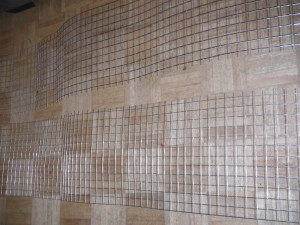
My first step was to split the wire in half lengthwise, giving me two strips that were 11 inches wide, and about 9 feet long.
When you cut wire, you will lose the width of one space, in this case 1 inch. Keep this in mind while planning.
With 11 inch wire, 9 feet long, I opted to run the wire on the inside of everything except the bottom panel. This would allow the eggs to roll out, and important factor for my quail cages. Therefore, I needed a frame that was about 12 inches tall (11 inches of wire plus the 1/2 inch of PVC. Since the 1/2 fittings add about an inch, I needed four 9 inch lengths for the uprights, and eight 22 inch lengths for the top and bottom frame.
I assembled the top with the legs first. I wanted to make sure I had a good fit on the bottom, so I did that part separately.
Then, I built the bottom square and placed the floor wire on top of it. Since the fitting took up part of the overall space of the floor, I needed to cut out the corners for a better fit.
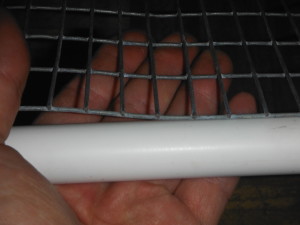 An important point regarding the floor. The 1×1/2 wire needs to be put in pace with the narrow spacing up, otherwise, the eggs will not roll.
An important point regarding the floor. The 1×1/2 wire needs to be put in pace with the narrow spacing up, otherwise, the eggs will not roll.
Here it is completely laid out. The wire was secured with cable ties that were then trimmed short. Unlike rabbits, quail do not gnaw on everything, so the nylon ties work fine.
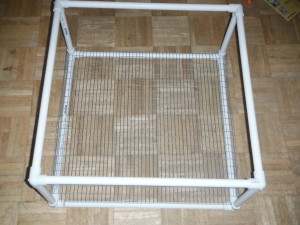 I then placed the top assembly on top and pressed each leg into the corresponding corner. Please note that at no time did I use any glue. This makes for easy disassembly for future project should I ever retire this cage. It also allows me to adjust the cage if needed without buying more parts. Friction and the cable ties do a great job of holding everything together.
I then placed the top assembly on top and pressed each leg into the corresponding corner. Please note that at no time did I use any glue. This makes for easy disassembly for future project should I ever retire this cage. It also allows me to adjust the cage if needed without buying more parts. Friction and the cable ties do a great job of holding everything together.
 The rest of the project was simply wrapping the 9 foot section around the frame, using cable ties to attach it to the bottom with the cable ties going around the PVC and bottom wire in a single loop. At each vertical corner, more cable ties were used to attach to the PVC. At the starting point, the wire was overlapped by an inch of wire and again attached with cable ties, with the excess wire trimmed off. The bottom of the wire was left long, to help deter any predators. Not sure if it helps, but that is a better excuse than, “I was too lazy to trim off the long wires”.
The rest of the project was simply wrapping the 9 foot section around the frame, using cable ties to attach it to the bottom with the cable ties going around the PVC and bottom wire in a single loop. At each vertical corner, more cable ties were used to attach to the PVC. At the starting point, the wire was overlapped by an inch of wire and again attached with cable ties, with the excess wire trimmed off. The bottom of the wire was left long, to help deter any predators. Not sure if it helps, but that is a better excuse than, “I was too lazy to trim off the long wires”.
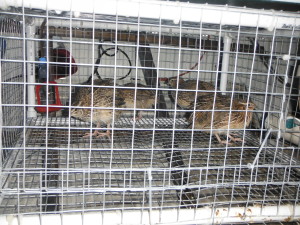 The top was simply a piece of the 24 x 24 wire attach with more cable ties. Over that was the coroplast that I had painted green on the underside, and left white on top. It didn’t quite cover the entire cage, so I opted to push of off to one wide, leaving room for a light and the hanging waterer on the side without a roof.
The top was simply a piece of the 24 x 24 wire attach with more cable ties. Over that was the coroplast that I had painted green on the underside, and left white on top. It didn’t quite cover the entire cage, so I opted to push of off to one wide, leaving room for a light and the hanging waterer on the side without a roof.
 For the door, I took a scrap piece larger than the opening I wanted. This was placed inside the cage and attached with more cable ties. Gravity keep it in a closed position, hopefully keeping the birds in, should there ever be a latch failure. In the picture, the door is outlined in red, the opening outlined in blue. Click the image for a better view.
For the door, I took a scrap piece larger than the opening I wanted. This was placed inside the cage and attached with more cable ties. Gravity keep it in a closed position, hopefully keeping the birds in, should there ever be a latch failure. In the picture, the door is outlined in red, the opening outlined in blue. Click the image for a better view.
You will notice a strip of wire at the bottom of the front of the cage. This will act as a one way door for eggs once the birds start laying. A catch tray will be put in place to collect the eggs as they roll out.
That’s it. I promise it took longer to write up than it did to actually do.
I’m sure I left out a lot of important details, its a failure of mine that I recognize. Most mechanical things come very easy to me, and I tend to leave out what is obvious to me. I apologize, and ask that if you have a question on how I did something, PLEASE ask!
This cage was simple to make, and should last a long time. If predators weren’t an issue for you, other than the flooring, you could even make this from plastic netting or screening, even chicken wire. There is room for improvement on the design, I’m sure, but you should have a good idea on how simple it use to make one of these.
So go get started, the quail eggs are in the incubator, you only have 17 days.
Let’s go!
Peace,
db
As always, please “like” FloridaHillbilly on Facebook, subscribe to my feed, follow me on Twitter, add it to Google+, Pinterest, Linkdn, Digg, and/or tell your friends! The more folks we can get to pull their heads out of the sand (or other dark places!), the better this country will become. Let’s not waste what our Founding Fathers did for us all those years ago.
Need something from Amazon (and who doesn’t)? I earn a small commission from purchases made when you begin your Amazon shopping experience here. You still get great Amazon service and your price is the same, no matter what.
Somebody gets the referral fee, why not allow this old Hillbilly use it to help make ends meet?

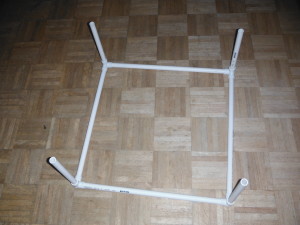
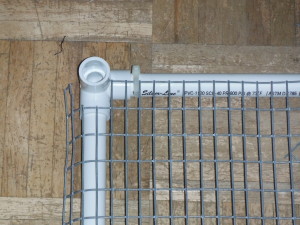
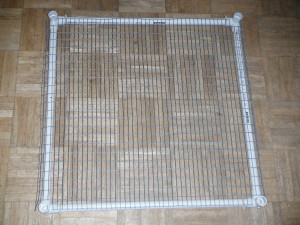
Nice tutorial. I (of course) have one question though: Would you show in more detail or close up where/how the eggs can roll out? I’m assuming there is a space along the length of the cage for the eggs to roll out, but didn’t see where you built that in.
I raise chickens, turkeys, ducks, geese and rabbits, and have been thinking about quail. I have to find out how they do in very cold climates though.
Peace out!
I’m on it….but I haven’t installed it on the cage I build for this tutorial yet. I’ll get it completed and post some pics soon.
I typically cut out the bottom inch of wire along the front, then install a 2-3 inch piece of wire that has been folded into a “U” shape to catch the eggs.
I’ll get on it to show how it works…a picture is worth a thousand words (and usually more clear than my explanations!)
Hey how’s it going? id like to see a video on your cage making and the egg rolling out I am a little confused about how to make that part of the cage. I’m on my way to Lowes today I have been trying to raise quail for year’s every time I would get started everything would be going smooth hatching raising them inside but twice I have put them outside in cages and the darn raccoon got them both times!! my chickens have taken a few hit’s too! so I have become pro active on that subject. So I am starting again and your post has boost my confidence again. I will post my tries on my Facebook ” Russell Ranch “(in east Tennessee) wish me luck my friend.
I have been trying to raise quail for year’s every time I would get started everything would be going smooth hatching raising them inside but twice I have put them outside in cages and the darn raccoon got them both times!! my chickens have taken a few hit’s too! so I have become pro active on that subject. So I am starting again and your post has boost my confidence again. I will post my tries on my Facebook ” Russell Ranch “(in east Tennessee) wish me luck my friend.
A video of this is on my (very extensive) list of things to do…
You might think about getting a dog, if raccoons continue to be a problem. 99% of my predator problems went away when we added a dog to the family. Plus a dog becomes an early warning system for visitors, both good and bad.
You can also try putting your bird cage within another cage, such as a large dog crate. This one would probably work:
http://amzn.to/1td7Chy
Raccoons are wily critters, and hard to thwart when they want something.
Thanks…..I like PVC and I was playing with this idea….you validated the idea …..and you said I don’t have to use glue….a big plus….
thanks for sharing…..
Yeah, I really like building with PVC, cleans up easily, is rather sturdy, and inexpensive too.
Hi there!
Thanks for sharing the simple PVC quail cage.
I miss seeing and hearing quail in my neighborhood in Central Florida so… I want to get a few quails and hopefully keep them around my backyard and the wooded lots next to our home and other wooded lots nearby.
I’ve been told if I can keep them for a few weeks in a cage feeding them , then let them out for a while and call them back for feed they might stick around.
What do you think ? Possible? Impossible?
Any ideas or suggestions?
Thanks,
Nelson
The quail I write about are “Coturnix” quail, a domesticated breed, NOT the bob whites that run wild.
I am a firm believer that a wild creature raised in captivity, such as bobwhites, would simply become snack if left to roam. In order to get them established, it would be a numbers game of dumping hundreds in the area to get a few to survive and become established.
A far better method, to my way of thinking, would be to figure out why the quail that used to live there no longer live there. Predation? Lack of food/shelter/water? Whatever the reason, by introducing more quail into the area without resolving the initial problem is simply throwing their lives away – whatever eradicated the wild quail would probably affect any quail you introduced, only faster.
But this is all guesswork on my part, no actual hands-on knowledge. SOMETHING eliminated the quail in your area, I’d start by looking to find what that something is/was.
Peace,
db
Thanks db,
I think it may have been a combination of diminished habitat and predation. I don’t think the habitat has been diminished all that much, there are still many undeveloped lots and vacant land in the vicinity. My guess is that their worse problem was predation from household cats that are left loose running havoc all night. Not much I can do about that.
Reconsidering…, may give up project or become a mega incubator, I have never incubated anything, so I don’t know.
Maybe I can introduce something that’ll eat the cats?
LOL, just kidding.
Thanks, if you think of something, let me know.
Nelson
I wasn’t going to open that can of worms, but since you have, I’ll jump up on my soapbox and bash all cat owners. House cats DEVASTATE wildlife.
“America’s cats, including housecats that adventure outdoors and feral cats, kill between 1.3 billion and 4.0 billion birds in a year, says Peter Marra of the Smithsonian Conservation Biology Institute in Washington, D.C., who led the team that performed the analysis. ”
Source:
https://www.sciencenews.org/article/cats-kill-more-one-billion-birds-each-year
Growing up on a farm in West Virginia, we had a couple feral cats that stayed out in our barn. We didn’t feed the cats, and we NEVER had a rat problem. When the cat population would get to be more than 4-5, my grandfather would go thin them out with a .22 rifle. He was very pragmatic. I like to think I get that from him
Cats are hunters. It is their nature to hunt and kill. Nothing can take that out of a cat.
Thin out the house cats in your area, and I’d bet you’d have a LOT more wildlife in your area.
db
Offensive? Only to cat lovers…that hate birds and small wild creatures.
You are preaching to the choir boy, I am with you 100 percent! Didn’t know the statistics, AMAZING! I have no need for cats, as far as I’m concerned they are an invasive exotic pest that should not be let loose to kill off native bird species.
Too bad I can’t thin out cats, may get in trouble.
Sorry cat lovers, if you really need one, keep it in your house!
Anyway, I think I should abandon the project. Don’t want to spend time and money only to be of no help, or worse, providing victims for cats.
What do you think?
I have seen a quail cage “somewhere” which had a PVC feeder. The owner simply cut 1/4 out of what looked like a 2 or 3″ pipe, put a cap on one end and an elbow on the other to pour food in. Looked simple enough to me.
Have you built a pan to put under your cage? I am thinking of an indoor setup and want an easy way to remove the droppings (and a holder for a few cedar chips for deodorizing/absorption).
I can’t tell what you are using as a waterer. Adapters to convert a 2-liter soda bottle are readily available and I assume would serve quite well (If you need more water, add another or switch to three liter soda bottles).
How many can you keep in a 24×24 cage? I have heard a dozen or so.
I use that same setup for my feeder. The horizontal portion is 1 1/2 PVC, with a cap on the end and then 2
“street” 45 degree fittings. The next section is a series of adapters ramping the 1 1/2 PVC up to 4 inch PVC. This gives me a large hopper for several days worth of feed.
I don’t use a pan, and since I don’t spray ANY pesticides on my property, I have a lovely colony of black soldier flies established under my quail. The black soldier fly larvae are fantastic consumers, eating everything that gets dropped onto them, including kitchen scraps I might bring by.
However, at one point, I was using an old portable dog crate, the kind with a built in tray. (Like this one http://amzn.to/1o5OKdK“) I cut the sides down, lowering the ceiling, and kept the tray in play. Worked fairly well, although I didn’t like the huge door that allowed the quail to make a break for it every time I had to open it to collect eggs.
Here are replacement trays that should be easy enough to incorporate into a quail pen you’ve made yourself.
http://amzn.to/1pvpfUt
A 24×24 cage can hold up to 16 birds without stressing them. The accepted standard for Coturnix quail is 36 square inches (6×6). 24×24 is 576 square inches. Divide that by 36, and you get 16. I use 24×36 and can hold 24.
I had far more hatch out than I had room for one time, and discovered a little trick allowing you crowd them a bit – put in a pan of sand or dirt for them to scratch and dust bathe in. But be warned, they throw dirt several feet in all directions.
But boy do they LOVE it! It keeps them occupied and what seems to be “happy”.
Hope that helps!
db